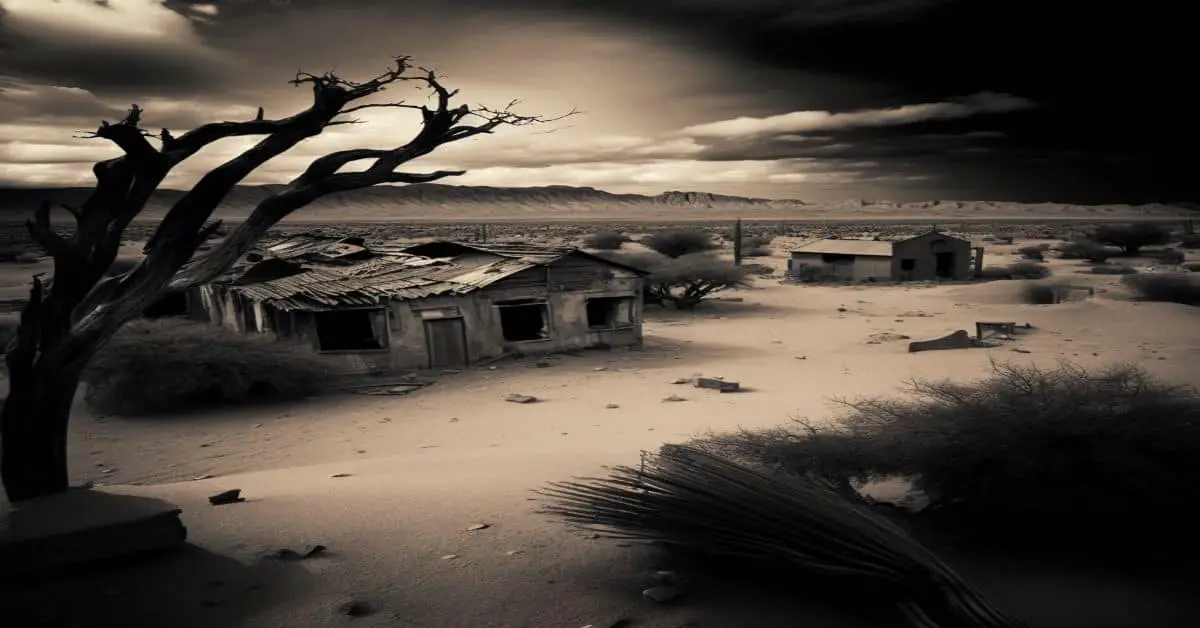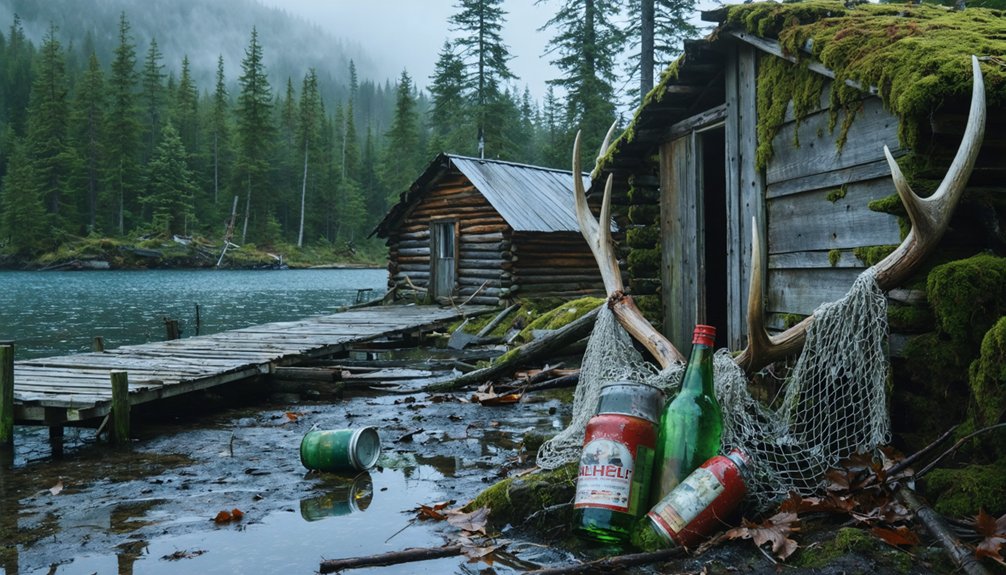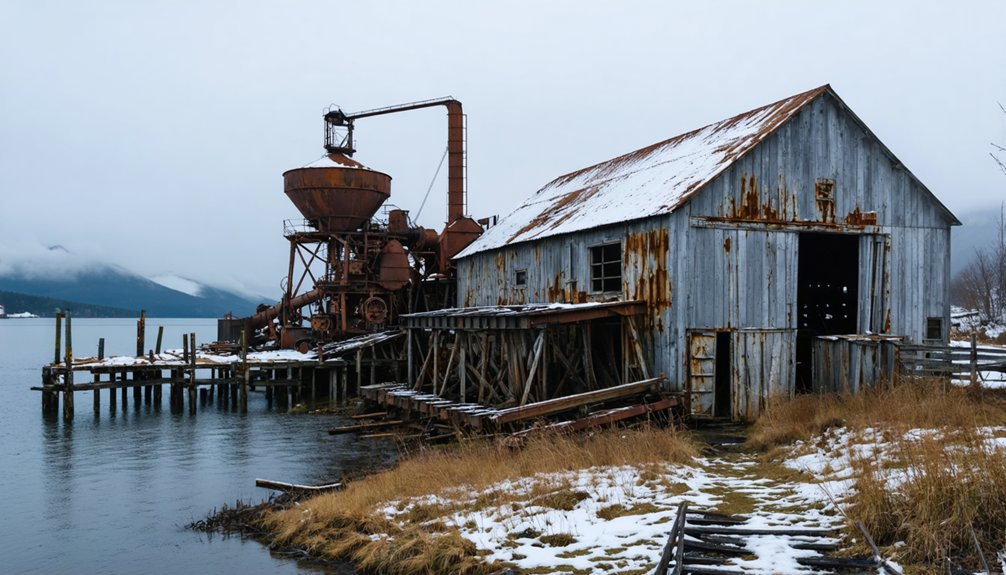You’ll find Kern’s remains along Alaska’s Turnagain Arm, where it once thrived as an essential railroad outpost in the early 1900s. The settlement supported thousands of workers during the Alaska Central Railway‘s expansion, peaking at 4,500 residents by 1917. The devastating 1964 earthquake and tsunami dealt the final blow to this remote community, and today nature has reclaimed most traces of human settlement. The story of Kern’s rise and fall reveals fascinating insights about Alaska’s railroad frontier.
Key Takeaways
- Kern was established in 1903 as a railroad outpost and became the northern terminus of Alaska Northern Railway by 1910.
- At its peak in 1917, the community supported 4,500 railroad construction workers during the line’s expansion toward Fairbanks.
- The town’s economic activity centered solely around railroad operations, with limited industrial diversification beyond basic transportation services.
- The devastating 1964 earthquake and tsunami significantly damaged the area, contributing to the town’s eventual abandonment.
- Natural reclamation has overtaken former structures, with dense vegetation and wildlife now dominating the former settlement’s location.
The Rise of a Railroad Settlement
As the Alaska Central Railway pushed northward from Seward in 1903, the settlement of Kern emerged as a crucial railroad outpost along Alaska’s first major rail line.
When the Alaska Central Railway went bankrupt in 1907, the reorganized Alaska Northern Railway Company extended the tracks to reach Kern Creek by 1910, establishing it as the northern terminus 71 miles from Seward.
You’ll find Kern’s significance grew substantially after 1914 when the U.S. government purchased the railroad and committed $35 million to expand the line to Fairbanks.
The community flourished during this period of railroad expansion, becoming a crucial logistical hub that supported up to 4,500 construction workers by 1917. Construction costs escalated from 9,680 dollars per mile in 1915 as development progressed northward.
Kern’s strategic location along Turnagain Arm made it central to community development and commerce in early territorial Alaska.
Like other place name disambiguation entries, Kern’s historical significance required careful documentation to distinguish it from other locations sharing the same name.
Life Along Turnagain Arm
While Kern’s residents faced challenging conditions along Turnagain Arm, the natural environment shaped their daily lives in remarkable ways.
You’d have found yourself surrounded by dramatic 3,000-5,000 foot peaks of the Chugach Mountains, where extreme tidal phenomena and wild weather patterns dictated daily routines. The low sun position created extraordinary light conditions throughout the year, casting long shadows across the rugged terrain. Wildlife interactions were commonplace in this rich ecosystem where land meets sea. The Seward Highway now offers visitors breathtaking views of these same landscapes that early settlers witnessed.
- You’d need to carefully time your coastal activities around the powerful bore tides, which could surge at speeds up to 20 mph.
- Beluga whales and Dall sheep would frequently grace your view from settlement vantage points.
- The surrounding boreal forests provided essential resources while offering shelter to diverse wildlife.
- Glacier-carved valleys and polished rock faces reminded you of nature’s raw power.
- Extreme snowfall averaging 800 inches annually meant winter survival required careful planning.
Economic Forces and Daily Operations
When Kern became the northern terminus of the Alaska Northern Railroad in 1914, the settlement’s economic identity was firmly established as a transportation outpost.
You’d find a transient workforce of railroad employees and laborers managing daily operations, with their lives revolving around train schedules and supply deliveries.
Despite federal investment in rail infrastructure, Kern faced significant economic stagnation.
You couldn’t find many local industries beyond basic railroad support services, and most goods had to be shipped in from Seward.
Unlike Kennicott’s booming copper operations which generated billions in profit during peak years, Kern struggled to establish any meaningful mining presence.
The settlement’s remote location and harsh environment made supply chains costly and unreliable.
Without gold or copper discoveries nearby, and lacking the population needed for sustained growth, Kern never developed the diverse economy needed to thrive as more than a minor transit point.
The region’s transportation needs were initially served by ocean-going vessels that carried freight and passengers before the railroad’s development.
The 1964 Tsunami’s Fatal Impact
The catastrophic Great Alaska Earthquake of March 27, 1964, released unprecedented destruction on coastal communities through its massive 9.2 magnitude and resulting tsunamis. The Prince William Sound epicenter triggered widespread devastation across southern Alaska.
A devastating 9.2 magnitude earthquake struck Alaska in 1964, unleashing tsunamis that shattered coastal communities with unrelenting force.
You’ll find the tsunami devastation was particularly severe, with waves reaching heights of 20-30 feet and multiple surges lasting 11 hours. The destruction tested coastal resilience like never before. The tsunami’s destructive power prompted the establishment of the Alaska Tsunami Warning Center in 1967.
- Energy released equaled 12,000 Hiroshima-type atomic bombs
- 122 lives were lost to the tsunami waves across Alaska, Oregon, and California
- Kodiak lost all but one docking facility, with over 215 structures destroyed
- $45 million in damages devastated Kodiak’s economy, leaving 600 homeless
- Land subsidence of up to 8 feet permanently altered the coastline, while some eastern areas saw uplift of 82 feet
- https://epcc.libguides.com/c.php?g=754275&p=5406070
- https://www.ghosttowns.com/states/ak/kern.html
- https://www.youtube.com/watch?v=Cz0IGc2Uy0E
- https://www.redbookmag.com/life/g34381869/ghost-towns-in-america/
- https://www.wikiwand.com/en/articles/Kern
- https://www.geotab.com/ghost-towns/
- https://en.wikipedia.org/wiki/List_of_ghost_towns_in_Alaska
- https://en.wikipedia.org/wiki/Kern
- https://www.lastfrontiermagazine.com/stories/history-of-the-alaska-railroad-part-ii
- https://www.alaskarailroad.com/corporate/history
Nature Reclaims the Land
Since Kern’s abandonment, nature has steadily reclaimed the former settlement through an intricate process of ecological succession.
You’ll find dense vegetation encroachment has obscured most remaining structures, with trees and native plants breaking through walls and floors of old buildings. The moist climate and rich soils of Chugach National Forest accelerate this transformation, as roots and moss gradually break down man-made materials.
Wildlife resurgence is equally dramatic. Birds, small mammals, and insects have established new habitats in the deteriorating structures, while the expanding vegetation provides food and shelter. Much like in Portage Ghost Town, the ruins serve as haunting reminders of nature’s dominance over human settlements.
Even the decay of wooden buildings contributes to soil enrichment, fostering further growth. Seasonal extremes and natural erosion continue reshaping the landscape, effectively erasing most traces of human presence except for scattered remnants in the undergrowth. The devastating 1964 tsunami further accelerated the area’s return to wilderness, washing away many of the remaining structures.
Frequently Asked Questions
Were There Any Churches or Schools Established in Kern?
You won’t find any church history or education facilities in this location – historical records don’t show evidence of churches or schools being established during the settlement’s brief existence.
What Indigenous Peoples Originally Inhabited the Area Around Kern?
While you’re scratching the surface of indigenous history, reliable records don’t paint a clear picture of which Native peoples specifically lived around Kern, though Alaska’s cultural heritage spans thousands of years.
How Much Did Housing and Basic Goods Cost in Kern?
You’ll find housing prices and basic goods costs aren’t directly documented for Kern, but they likely mirrored Alaska’s higher regional costs due to remoteness, transportation challenges, and supply chain limitations.
Did Any Famous Individuals or Notorious Criminals Pass Through Kern?
You won’t find records of any famous visitors or notorious outlaws in Kern, except for U.S. Secretary of the Interior Walter L. Fisher’s brief inspection tour in 1911 during railroad construction.
What Types of Wildlife Were Commonly Encountered by Kern’s Residents?
You’d encounter abundant local fauna including grizzly bears, wolves, moose, and mountain goats, plus bald eagles overhead. Wildlife encounters also included salmon in streams, beavers, and pesky mosquitoes year-round.



